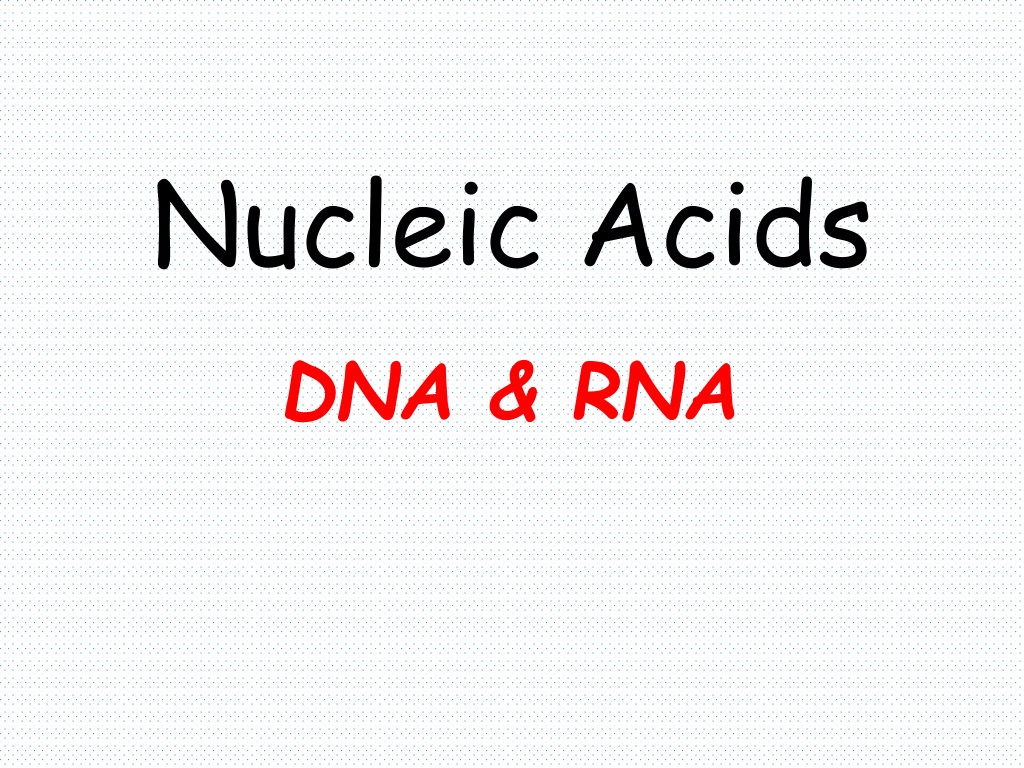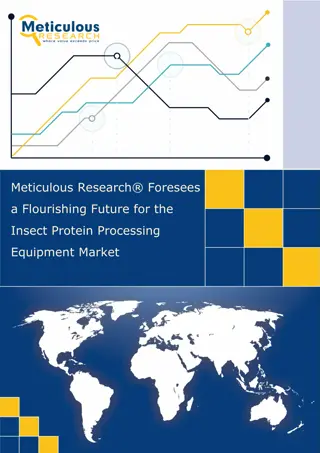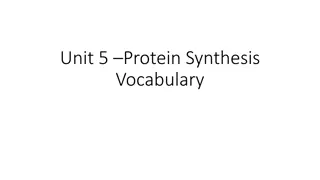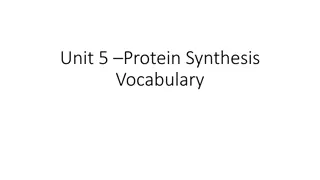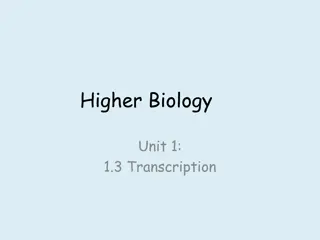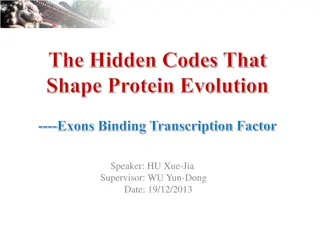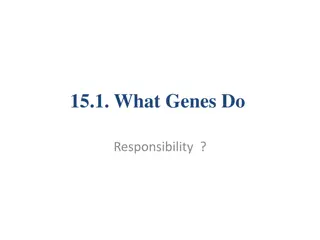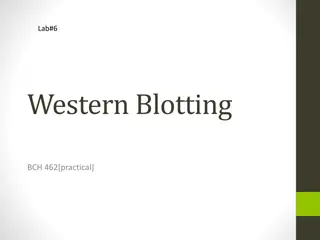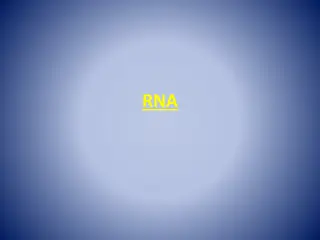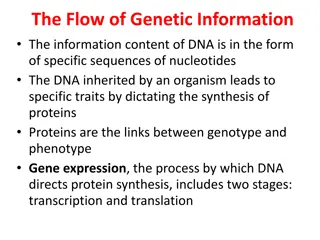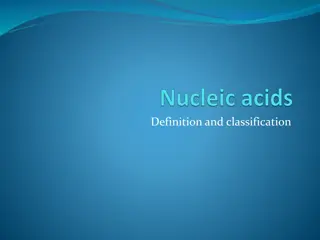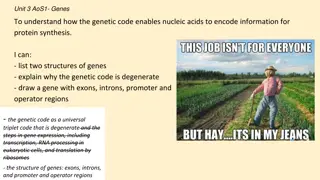Understanding the Genetic Code and Protein Synthesis
Explore the fascinating world of nucleic acids, DNA, RNA, and the genetic code. Discover how the sequence of nucleotides in mRNA translates into amino acids, forming proteins. Learn about codons, ribonucleotides, and the triplet code, and unravel the process of reading the genetic code to determine amino acid sequences. Delve into the intricate mechanisms that govern protein synthesis within cells.
Download Presentation

Please find below an Image/Link to download the presentation.
The content on the website is provided AS IS for your information and personal use only. It may not be sold, licensed, or shared on other websites without obtaining consent from the author. Download presentation by click this link. If you encounter any issues during the download, it is possible that the publisher has removed the file from their server.
E N D
Presentation Transcript
Nucleic Acids DNA & RNA
The Genetic Code The genetic code is found in the sequence of nucleotides in mRNA that is translated from the DNA A codon is a triplet of bases along the mRNA that codes for a particular amino acid Each of the 20 amino acids needed to build a protein has at least 2 codons There are also codons that signal the start and end of a polypeptide chain The amino acid sequence of a protein can be determined by reading the triplets in the DNA sequence that are complementary to the codons of the mRNA, or directly from the mRNA sequence The entire DNA sequence of several organisms, including humans, have been determined, however, - only primary structure can be determined this way - doesn t give tertiary structure or protein function
Genetic code The sequence of bases in DNA forms the Genetic Code A group of three bases (a triplet) controls the production of a particular amino acid in the cytoplasm of the cell The different amino acids and the order in which they are joined up determines the sort of protein being produced
Coding For example Cytosine Codes for Valine Adenine Thymine Cytosine (C) Codes forAlanine Guanine (G) Adenine (A)
Triplet code This is known as the triplet code Each triplet codes for a specific amino acid CGA - CAA - CCA - CCA - GCT - GGG - GAG - CCA - Ala Val Gly Gly Arg Pro Leu Gly The amino acids are joined together in the correct sequence to make part of a protein Ala Val Gly Gly Arg Pro Leu Gly
Reading the Genetic Code Suppose we want to determine the amino acids coded for in the following section of a mRNA 5 CCU AGC GGA CUU 3 According to the genetic code, the amino acids for these codons are: CCU = Proline GGA = Glycine CUU = Leucine AGC = Serine The mRNA section codes for the amino acid sequence of Pro Ser Gly Leu
Translation and tRNA Activation Once the DNA has been transcribed to mRNA, the codons must be tranlated to the amino acid sequence of the protein The first step in translation is activation of the tRNA Each tRNA has a triplet called an anticodon that complements a codon on mRNA A synthetase uses ATP hydrolysis to attach an amino acid to a specific tRNA
Initiation and Translocation Initiation of protein synthesis occurs when a mRNA attaches to a ribosome On the mRNA, the start codon (AUG) binds to a tRNA with methionine The second codon attaches to a tRNA with the next amino acid A peptide bond forms between the adjacent amino acids at the first and second codons The first tRNA detaches from the ribosome and the ribosome shifts to the adjacent codon on the mRNA (this process is called translocation) A third codon can now attach where the second one was before translocation
Termination After a polypeptide with all the amino acids for a protein is synthesized, the ribosome reaches the the stop codon: UGA, UAA, or UAG There is no tRNA with an anticodon for the stop codons Therefore, protein synthesis ends (termination) The polypeptide is released from the ribosome and the protein can take on it s 3-D structure (some proteins begin folding while still being synthesized, while others do not fold up until after being released from the ribosome)
DNA and enzymes The proteins build the cell structures They also make enzymes The DNA controls which enzymes are made and the enzymes determine what reactions take place The structures and reactions in the cell determine what sort of a cell it is and what its function is So DNA exerts its control through the enzymes
Genes A sequence of triplets in the DNA molecule may code for a complete protein Such a sequence forms a gene There may be a thousand or more bases in one gene
Conformation around N-Glycosidic Bond Relatively free rotation can occur around the N-glycosidic bond in free nucleotides The torsion angle about the N-glycosidic bond (N-C1') is denoted by the symbol The sequence of atoms chosen to define this angle is O4'- C1'-N9-C4 for purine, and O4'-C1'-N1-C2 for pyrimidine derivatives Angle near 0 corresponds to syn conformation Angle near 180 corresponds to anti conformation Anti conformation is found in normal B-DNA
Replication of Genetic Code Strand separation occurs first Each strand serves as a template for the synthesis of a new strand Synthesis is catalyzed by enzymes known as DNA polymerases Newly made DNA molecule has one daughter strand and one parent strand. It has not escaped our notice that the specific pairing we have postulated immediately suggests a possible copying mechanism for the genetic material Watson and Crick, in their Nature paper,1953
Messenger RNA: Code Carrier for the Sequence of Proteins Is synthesized using DNA template Contains ribose instead of deoxyribose Contains uracil instead of thymine One mRNA may code for more than one protein
Factors Affecting DNA Denaturation The midpoint of melting (Tm) depends on base composition high CG increases Tm Tm depends on DNA length Longer DNA has higher Tm Important for short DNA Tm depends on pH and ionic strength High salt increases Tm
